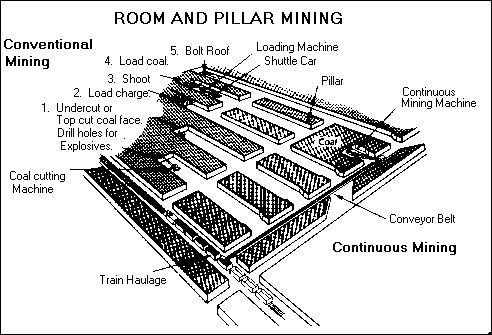|
|

This drawing depicts the room and pillar method of underground mining. Most underground coal is mined by the room and pillar method, whereby rooms are cut into the coal bed leaving a series of pillars, or columns of coal, to help support the mine roof and control the flow of air. Generally, rooms are 20-30 feet wide and the pillars up to 100 feet wide. As mining advances, a grid-like pattern of rooms and pillars is formed. When mining advances to the end of a panel or the property line, retreat mining begins. In retreat mining, the workers mine as much coal as possible from the remaining pillars until the roof falls in. When retreat mining is completed, the mined area is abandoned.
There are two types of room and pillar mining--conventional mining and continuous mining. Conventional mining is the oldest method and accounts for only about 12% of underground coal output. In conventional mining, the coal seam is cut, drilled, blasted and then loaded into cars. Continuous mining is the most prevalent form of underground mining, accounting for 56% of total underground production. In continuous mining, a machine known as a continuous miner cuts the coal from the mining face, obviating the need for drilling and blasting.
Click here to see underground miners at work.